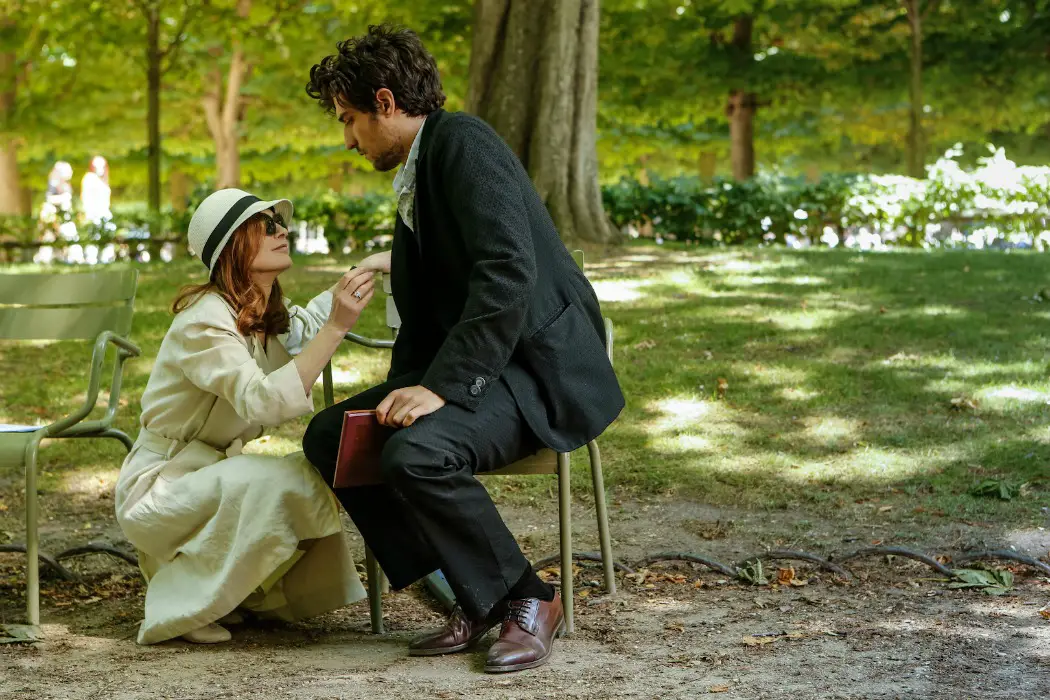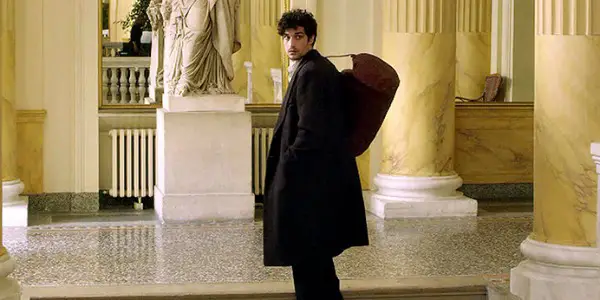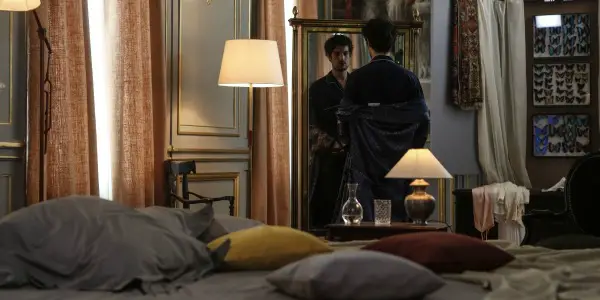FALSE CONFESSIONS: A Terminal Truth

In Luc Bondy’s final film, False Confessions, he transposes Marivaux’s stage play on to film, and into the 21st century. Academy Award nominee Isabelle Huppert depicts Araminte; a social and affluent widow, adorned in the finest Dior silks of delicate whites and soft metallics. An elegant sartorial palette which only further serves the highly saturated and veristic aesthetic of Bondy’s film, softened with its playful antics.
Acting as Araminte’s accountant is Dorante (Louis Garrel), who falls hopelessly in love with his employer, yet plans to pilfer her vast fortune. Seemingly the blurring line between lies and secrets mirror the on screen visual style. The fervent plotting beneath the surface is not solely reserved for Dorante. Both the housekeeper, Mademoiselle Marton (Manon Combes), and her own mother, Madame Argante (Bulle Ogier), attempt to marry off Araminte to a rich count, Comte Dorimont (Jean-Pierre Malo), in an effort to avoid a land dispute.

Dorante attempts to convince Araminte that she would be triumphant in court, in the hope of securing both her affections and fortune for himself. Ultimately, Dorante serves as a intermediary for those upstairs and down. He first hears about the job opening from the house servants; Dubois (Yves Jacques) and Marton – who is deemed a potential suitor for him by his uncle, although Dorante sets his sights higher.
From Stage to Screen
For fans of the French theatre circuit, Marivaux is considered a household name and subject matter for the French curriculum. Not quite Moliere, who is dubbed the ‘Shakespeare of France’, he remains a much beloved writer of the nation due to the trio of plays; Game of Love and Chance, the Triumph of Love and Les Fausses Confidences (False Confessions). The latter of which has seen three film adaptations, in 1984, 2010 and 2016.
Bondy was the manager at the Paris Odeon between 2012 and 2015, and many believe this film was a concrete homage to his time there – False Confessions itself features the infamous columned hall, staircase and an exterior balcony which overlooks Place de L’Odeon. He unfortunately never saw the finished product, as he succumbed to pneumonia in 2015. His wife, Marie-Louise then assisted in the completion of the film.

At points throughout False Confessions, the flare from the camera lens can act as an analeptic – resulting in the character’s silhouettes being blurred by an ethereal glow. Cinematographer, Luciano Tovoli, utilises medium moderate shots with scenes, varying from luminous to somber darkly lit rooms. The film’s lavish baroque score often hinders, rather than enhances the minimalist on screen presence. Those familiar with the play will enjoy subtle stylistic notes throughout the film, for example, the scattering of women’s shoes in the stairwell of the theatre’s foyer.
Points Forts et Faibles
With a varying set of agendas at work to benefit each individual, the narrative focuses on the futility and malleability of love. False Confessions itself showcases the premise in its truest form, sincere at first and then evolving into parody under the meticulous guidance of Bondy. Love is a hard prospect to invest in, in such a conceited world, and this is a contemporary take on the psychology of affection. Marivaux described the premise of the play as about “the eternal surprise of love”.
An accomplished and seasoned veteran of both stage and screen, Huppert demonstrates her wealth of experience through a subtle and elegant performance, rivaling her gossamer like costumes. Her acting is pleasantly underpinned by Louis Garrel’s depiction of the perfidious Daronte. There are several occasions whereby the physical comedy showcases Bondy for the painfully meticulous director that he was. A particular favourite among critics is when Huppert effortlessly tosses some wrapping paper in the general direction of Ogier, illustrating their complicated relationship and also making the audience laugh out loud.

False Confessions doesn’t quite cohesively unite both the modern props and amalgam of settings; complicated by elements such as the anachronistic language and social preconceptions of wealth and marriage. Traversing the test of time is the film’s setting of the Odeon, due to its elegant architectural notes from the early 1800’s. However, what shatters the illusion somewhat is that Bundy elects to film from a vantage point obscured by cars or the modern costumes, in particular Madame Argantes’s sunglasses.
It seems abstract and affects False Confessions‘s aesthetic as a whole, impacting its attempt to contrast with the older elements utilised, unlike the convincing take on Shakespeare’s Romeo and Juliet by director Baz Luhrmann. The polar opposite nature of the components that made up that film, like the eclectic soundtrack and neon visuals, while harsh at times, ultimately worked.
In Conclusion: False Confessions
False Confessions is an enjoyable watch with Huppert and the rest of the cast giving excellent performances. It provides some light laughs has a great narrative pace. Even fans of the original production will be on their proverbial toes towards the films conclusion, as Bondy has put in a few surprise twists – not forgetting seeing Huppert, normally the epitome of sartorial elegance, wearing a gold tracksuit.
The death of Bondy lends a real poignancy to the film’s viewing, but was it what he truly wanted? What was performed on-stage didn’t quite make its way onto its screen counterpart, despite its mirrored cast.
What are your favourite adaptations from play to screen? Do you think Baz Luhrmann’s Macbeth?
False Confessions was released in the US on the 21st of July. For the release date in your country see here.
Does content like this matter to you?
Become a Member and support film journalism. Unlock access to all of Film Inquiry`s great articles. Join a community of like-minded readers who are passionate about cinema - get access to our private members Network, give back to independent filmmakers, and more.













